- Vehicle Guide
- Driving in Iceland
- Our services
- Locations & Hours
- Travel Inspiration
- South Iceland: A complete guide
- Reynisfjara Beach in Iceland - Your Guide to a Safe Visit
- North Iceland: A Complete Guide for Drivers
- East Iceland A Complete Guide for Drivers
- West Iceland The Complete Driver’s Guide
- Your Ultimate Guide to Exploring Iceland’s Ring Road
- Driving the Diamond Circle in Iceland: Your Ultimate Guide
- Driving Iceland's Golden Circle: Your Ultimate Guide
- A 10-Day Itinerary in Iceland: Tips + Ideas
- The Perfect Itinerary for 7 Days in Iceland
- The Best Time to See the Northern Lights in Iceland with a Rental Car
- Renting a Camper in Iceland: The Complete Guide
- Getting to Iceland: A Comprehensive Guide on How to Reach the Land of Fire and Ice
- Nature Bath Locations in Iceland: A Complete Guide
- Iceland with Kids: A 5-Day Self-Drive Itinerary
- Winter Driving in Iceland: A Comprehensive Overview for Foreign Tourists
- The Total Solar Eclipse in Iceland – August 12, 2026
- Exploring Iceland's National Parks on a Self-Drive Adventure
- Exploring Iceland's Wonders: A Comprehensive Guide to Activities and Car Rentals
- Springtime in Iceland – Your Comprehensive Travel Guide
- Exploring Iceland's Most Popular Highland Routes
- The Pearls of Westfjords: The Ultimate Guide
- Exploring Iceland's Hidden Gems | Off-the-Beaten-Path Adventures
- Driving in Iceland in June: Tips for a Safe and Scenic Summer Road Trip
- Driving in Iceland in July: Tips, Routes & Rentals
- Driving in Iceland in August: Late-Summer Freedom on the Open Road
- Guide to Skaftafell Iceland Self-Drive A Journey Through Fire and Ice
- Eco-Friendly Road Trips in Iceland, Sustainable Travel Tips
- Photographer’s Paradise Top Scenic Drives in Iceland for Stunning Shots
- Iceland's Folklore and Legends A Road Trip Through Mythical Sites
- Iceland’s Midnight Sun and How to Make the Most of 24-Hour Daylight
- Chasing Waterfalls: A Road Trip to Iceland’s Most Spectacular Cascades
- Iceland's Volcanic Wonders: A Self-Drive Tour of Active and Dormant Volcanoes
- Tee Off in the Land of Fire and Ice: A Guide to Golfing in Iceland
- Birdwatching in Iceland: Puffins and Beyond
- Iceland’s Diverse Beaches: Beyond the Black Sands
- Icelandic Horses: The Unique Breed of the North
- Beyond the Ring Road: Iceland’s Hidden Scenic Drives
- Iceland’s Ice Caves: A Year-Round Adventure
- Wildlife Watching in Iceland: Where and When to Go
- Iceland’s Hidden Hot Springs: A Self-Drive Guide to Secret Soaks
- Navigating Iceland’s Weather: What to Expect Each Season
- Tröllaskagi Peninsula: Iceland’s Mountainous Marvel — A Scenic Road Trip with Höldur
- Mastering Iceland's Roundabouts: A Driver’s Guide
- Essential Tips for Renting a Car in Iceland
- Navigating Iceland’s One-Lane Bridges: Your Guide to Safe and Scenic Crossings
- Exploring Iceland’s Film Locations by Rental Car
- 5 Must-Visit Destinations Within Two Hours of Keflavík Airport
- Seasonal Car Rental Tips for Iceland’s Summer Festivals
- Understanding Iceland's F-Roads: How to Drive Safely Into the Highlands
- What Makes Iceland Unique: Top 15 Highlights for an Unforgettable Journey
- Driving and Hiking in Harmony: Explore Iceland's Natural Wonders with Höldur Car Rental
- What is the Best Car to Rent in Iceland?
- Avoiding Common Car Rental Mistakes in Iceland
- Making Your Car Rental in Iceland Child-Friendly: Tips for Stress-Free Family Travel
- Exploring Akureyri, Iceland’s Northern Gem, with EasyJet and Europcar
- Renting a Manual or Automatic Car in Iceland
- Discover the Arctic Coast Way in Iceland with Höldur Car Rental
- How to Save on Fuel Costs During Your Iceland Road Trip
- Electric vs. 4x4 Rentals in Iceland: Which is Right for Your Trip?
- Top Scenic Detours Off Iceland's Ring Road
- Top Safety Tips for First-Time Drivers on Iceland’s Roads
- Cultural Pit Stops Along Iceland’s Ring Road
- Your Guide to Exploring Stuðlagil Canyon by Car: Iceland’s Basalt Beauty Awaits
- Day Trip Ideas From Reykjavik by Rental Car
- Visit Glymur Waterfall: The Ultimate Self-Drive Adventure from Reykjavík
- Discover the Volcanic Wonders of Lake Mývatn by Car
- Discovering the Magic of Snæfellsnes Peninsula by Car
- Your Self‑Drive Guide to Gullfoss Waterfall
- A Guide to Seljalandsfoss Waterfall in Iceland: Explore by Car
- Exploring Reykjanes Peninsula A Self Drive Guide
- Exploring Iceland Landmannalaugar by 4x4
- A Beginner's Guide to River Crossings in Iceland
- Best Car Rental Offers for Iceland’s Summer Adventures
- Your Self‑Drive Guide to Þingvellir National Park
- Your Ultimate Guide to Geysir, Iceland: All You Need to Know
- How to Pay for the Vaðlaheiðargöng Tunnel
- Your Guide to Visiting Jökulsárlón Glacier Lagoon
- The Diamond Beach in Iceland: A Sparkling Wonder Worth Visiting
- Parking fines in Iceland: how to pay and what to do if you receive one
- Where to find overnight parking in Reykjavík: a local’s guide for travellers
- How to park for free in Reykjavík: tips to save on your Iceland trip
- How to pay for parking in Reykjavík - A friendly guide for drivers in Iceland
- Game of Thrones Filming Locations in Iceland: A Self-Drive Guide
- How to Choose the Right Car Rental at Keflavík Airport
- Flying Within Iceland: Your Guide to Domestic Routes and Regional Airports
- Top 3 Must-See Attractions on Iceland's Golden Circle
- Hidden Gems Along the Golden Circle Route
- Your Essential Guide to Iceland: Currency, Culture, and Car Rental Tips
- How to Plan the Perfect Golden Circle Self-Drive Tour
- The Comprehensive Guide to Rental Car Sizes at Keflavik Airport
- Húsafell & Hallmundarhraun: Hidden Lava Field Adventures by Car
- Iceland Weather by Month: What to Expect and How to Drive Safely with Holdur Car Rental
- A Guide to Iceland’s Quirky Roadside Attractions
- Exploring Iceland’s Lava Tubes | Self-Drive Cave Adventures with Höldur Car Rental
- Coolcation in Iceland: Self-Drive Your Summer Escape to the North
- Driving Iceland’s Coastal Roads: A Guide to Lesser-Known Peninsulas
- Top Tips for Driving in Iceland Safely Year-Round
- The Best Rest Stops and Viewpoints Along Iceland's Ring Road
- Driving in Iceland in September: Embrace the Autumn Adventure
- Your Guide to Exploring Fjaðrárgljúfur – South Iceland’s Fairytale Canyon
- Explore Reykholt on a Self-Drive Tour in Iceland
- How to Choose the Right Insurance for Your Iceland Car Rental
- Hiking Múlagljúfur Canyon: Iceland’s Hidden Gem You Can’t Miss
- Understanding Iceland's Weather and How It Affects Driving Conditions
- Dyrhólaey: A Complete Self-Drive Guide to Iceland's Breathtaking South Coast
- Where to See Iceland’s Tectonic Plates Up Close
- Scenic Journey on Kjalvegur Road 35 Reykjavik to Akureyri
- Guide to Visiting Svartifoss with a Rental Car
- Kerið Crater Lake in Iceland: A Self-Drive Guide
- Your Complete Guide to Stokksnes, Iceland with a Rental Car
- Hengifoss Waterfall in Iceland: The Ultimate Self-Drive Guide
- Your Complete Guide to Visiting Skógafoss Waterfall with a Rental Car
- Into the Heart of Þórsmörk: Iceland’s Valley of Thunder
- Dynjandi Waterfall in Iceland: The Ultimate Self-Drive Guide
- Visiting Ásbyrgi Canyon in North Iceland by Car: A Complete Self-Drive Guide
- Driving in Iceland in October: Embrace the Autumn Transition

Travel information
North Iceland: A Complete Guide for Drivers
12.06.2024
With whale-watching opportunities, famed hot springs, and delightful towns and villages, North Iceland is one of the country’s must-visit regions. And the easiest way to explore this diverse and fascinating area is in a rental car.
In this guide, you’ll learn everything you need to about seeing North Iceland by car. Read on to discover top sights, travel tips, and details on the new road trip itinerary, the Arctic Coast Way.
- Find out more in our guide to driving in Iceland
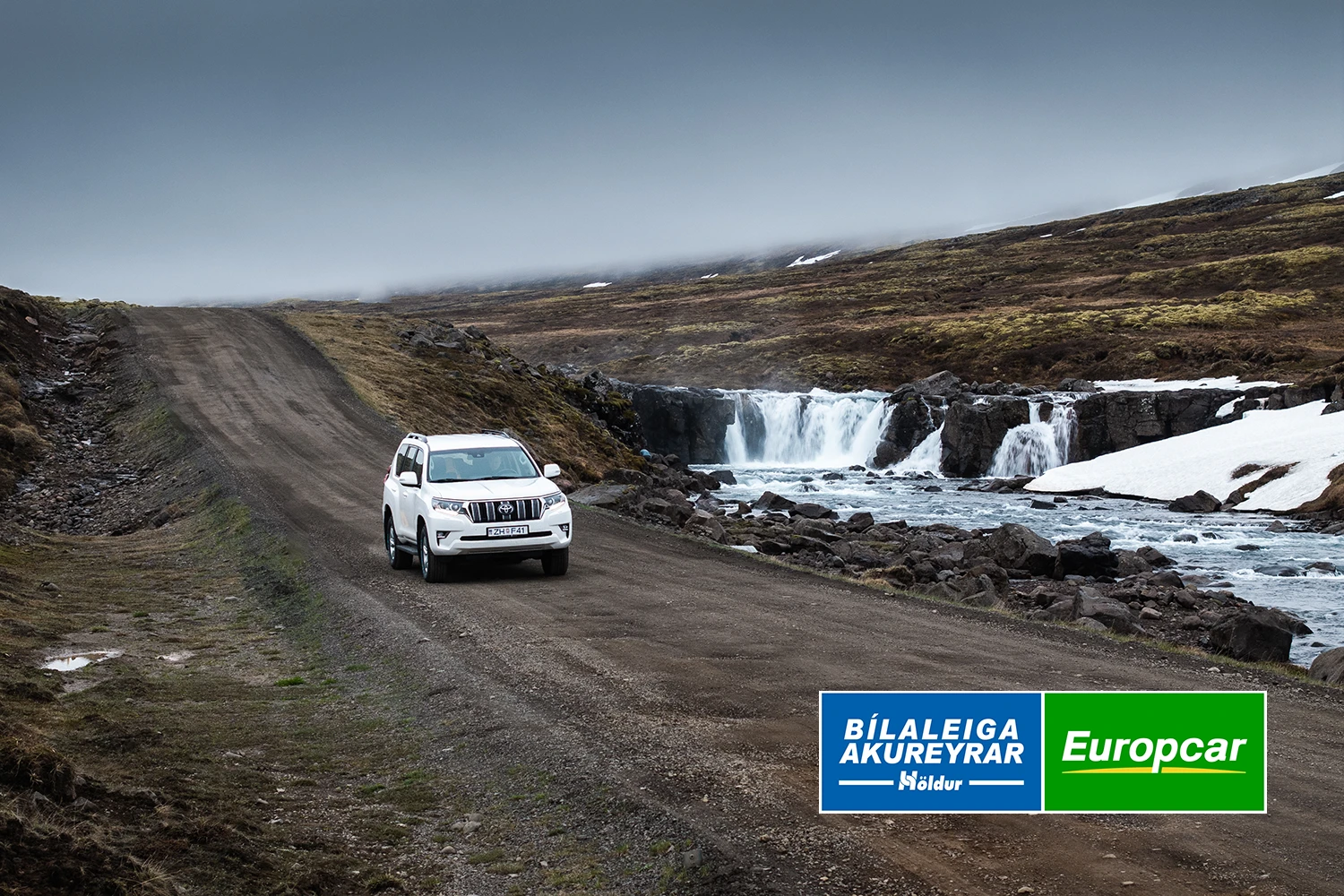
Why explore North Iceland?
Most visitors to Iceland limit themselves to the area around Reykjavík and the south coast. While that’s convenient for international travel, it does mean they’re missing out on many of Iceland’s most remarkable sights—including in North Iceland.
North Iceland is the region that encompasses the whole of the country’s northern coast. The jewel in its crown is Akureyri, the so-called “Capital of the North”. This town is Iceland’s second-largest, and it sits in a superbly scenic location on the shores of the Eyjafjörður. If you visit North Iceland, you’ll likely pass through it.
But why come to North Iceland? Here are 5 good reasons to explore.
- North Iceland is renowned for its whale watching. Iceland hosts as many as 20 different species of whale and dolphin throughout the year, and most of them come to the country’s north coast.
You can take boat tours from Akureyri, but you might have a better chance to see the region’s minke whales, orcas, and more at Húsavík. Sitting on the Skjálfandi Bay, Húsavík is the historic centre of Iceland’s whaling culture. From the village today, sightings of whales in summer are almost guaranteed.
- North Iceland tends to have better weather. Typically, in summer, North Iceland is drier, milder, and better protected from the wind than the south coast. With the sun more likely to shine, you’ll have more chances to see the region’s gorgeous landscapes.
In winter, North Iceland is slightly colder, but you’ll still be more likely to see dry days.
- North Iceland promises the best opportunities to see the northern lights. To witness the northern lights in Iceland, it’s best to be as far north as possible. On top of that, you need clear skies, very dark nights, and little light pollution.
North Iceland is on the edge of the Arctic Circle, making it the ideal spot for northern lights hunters. You’ll need to come between the months of September and April to see them at their best.
- North Iceland is home to a dazzling array of natural sights. Northern Iceland showcases some of the country’s most breathtaking natural wonders. For instance, see mysterious rock formations and expansive ocean views, thunderous waterfalls and vast geothermal lakes.
There’s much more to explore too. For instance, in a rental car, wind your way along the Arctic Coast Way, to witness Iceland’s most dramatic fjords and mountain landscapes.
- North Iceland has two of the most impressive travel itineraries. You’ll likely have heard of the Golden Circle in Iceland, but the north has two of its own road trip routes that are just as impressive.
The Diamond Circle takes in sights such as Lake Mývatn, Dettifoss Waterfall, and the Ásbyrgi Canyon. Meanwhile, the brand-new Arctic Coast Way is a dramatic journey through Iceland’s fjords and peninsulas.
Inspired? In the next section, you’ll discover some of North Iceland’s major sights in detail.
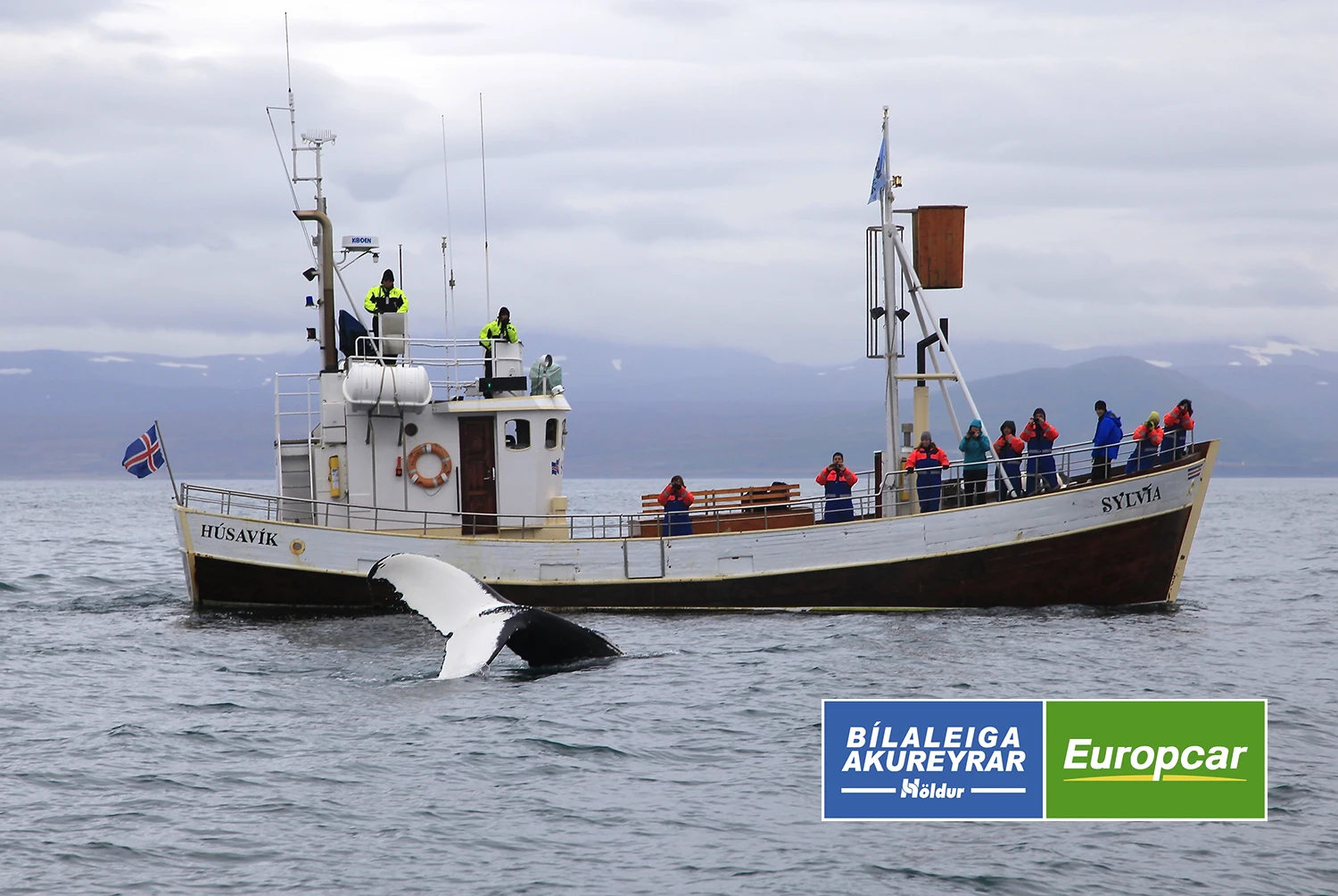
What to do in North Iceland
North Iceland is packed with welcoming towns, jaw-dropping scenery, and fascinating natural wonders. Here are 6 sights and activities not to miss on your visit.
1. Visit Akureyri, the Capital of the North
With a population of about 20,000, Akureyri is North Iceland’s largest hub (and the country’s second-biggest town after Reykjavík). Visit the “Capital of the North” for culture, restaurants, and opportunities for whale-watching trips.
A walking tour through the old town will show you buildings that date back centuries. For instance, the wooden house, Laxdalshús, was built in 1795, while other landmarks in the town are from the beginning of the nineteenth century.
While you’re here, don’t miss Lystigarðurinn, Akureyri’s beloved botanic garden. Plus, the Icelandic Folk Art Museum gives you a glimpse of the country’s fascinating historic culture.
2. Explore Lake Mývatn and its ancient volcanic surroundings
If you’re driving Iceland’s Ring Road, you won’t miss Lake Mývatn. It’s a vast body of water that extends over 37 square kilometres (14 square miles). And like much else of Iceland’s landscapes, it was created by an ancient volcanic eruption.
Today, Mývatn is recognised by UNESCO World Heritage as one of the most biodiverse areas in Iceland. In fact, it has some of the most varied bird life that you’ll find anywhere this far north in the world.
The lake itself is the centrepiece of a much larger volcanic area, featuring eerie rock formations such as Dimmuborgir, craters such as Skútustaðagígar, and hot springs. You can spend hours exploring everything the area has to offer.
3. Take a sealife tour from Húsavík, Iceland’s whale watching hub
When visiting northern Iceland, make sure to stop off at Húsavík. It’s a quaint village with a scattering of historic buildings which overlook the graceful Skjálfandi bay.
However, it’s best known for its history of whaling. You can dive into this story at the Húsavík Whale Museum, which shares how these magnificent creatures sustained much of this community. Or check out the Exploration Museum, for exhibits on Viking explorers, Arctic expeditions, and more.
You’ll find the most rewarding experience at sea. Hop onto a whale-watching tour to see orcas, sei whales, dolphins, and sometimes even a mighty blue whale.
4. Tour the Diamond Circle
The Diamond Circle is a 250 km (155 mi) itinerary in North Iceland that shows you some of the region’s natural wonders. You can start from Akureyri, Húsavík, or somewhere else (such as a local hotel) and tour the loop in a day.
Highlights include the magical Lake Mývatn and the whaling hub of Húsavík. But there’s much more to see besides.
For instance, stop off at Ásbyrgi, an enormous horse shoe-shaped canyon that’s carved out of the landscape. Beneath its high cliffs is a sheltered world of lush vegetation to explore.
Then visit the mighty waterfalls of Dettifoss and Goðafoss. While Dettifoss is known for its surging power, Goðafoss is an evocative and mysterious place.
Find out more about driving the Diamond Circle.
5. Drive along the Arctic Coast Way
The Arctic Coast Way is a brand new driving itinerary along North Iceland’s breathtaking coastline. Having only opened in 2019, the route offers an off-the-beaten-track experience encompassing the very best of Iceland’s north.
The itinerary stretches about 900 km (559 mi) between Hvammstangi in the west and Bakkafjörður in the east. When you set out on your northern road trip, it’ll take you along dramatic peninsulas and through breathtaking mountain passes.
As part of your journey, you can also explore the islands off Iceland’s north coast, such as Grímsey. It’s known for its birdlife and its dramatic location on the edge of the Arctic Circle.
6. Unwind in geothermal baths and spas
Iceland as a whole is known for its geothermal activity and natural spas. But in North Iceland you can leave some of the busier wellness destinations behind and indulge in more peaceful spa experiences.
For instance, try the Mývatn Nature Baths, a spa resort on the edge of the Mývatn geothermal area. Or try Geosea, whose spa pool overlooks the Arctic Ocean. Another option is to visit the modern facilities at Forest Lagoon, just outside of Akureyri.
On a busy trip through the wonders of North Iceland, a visit to a spa can be a rejuvenating and luxurious experience.
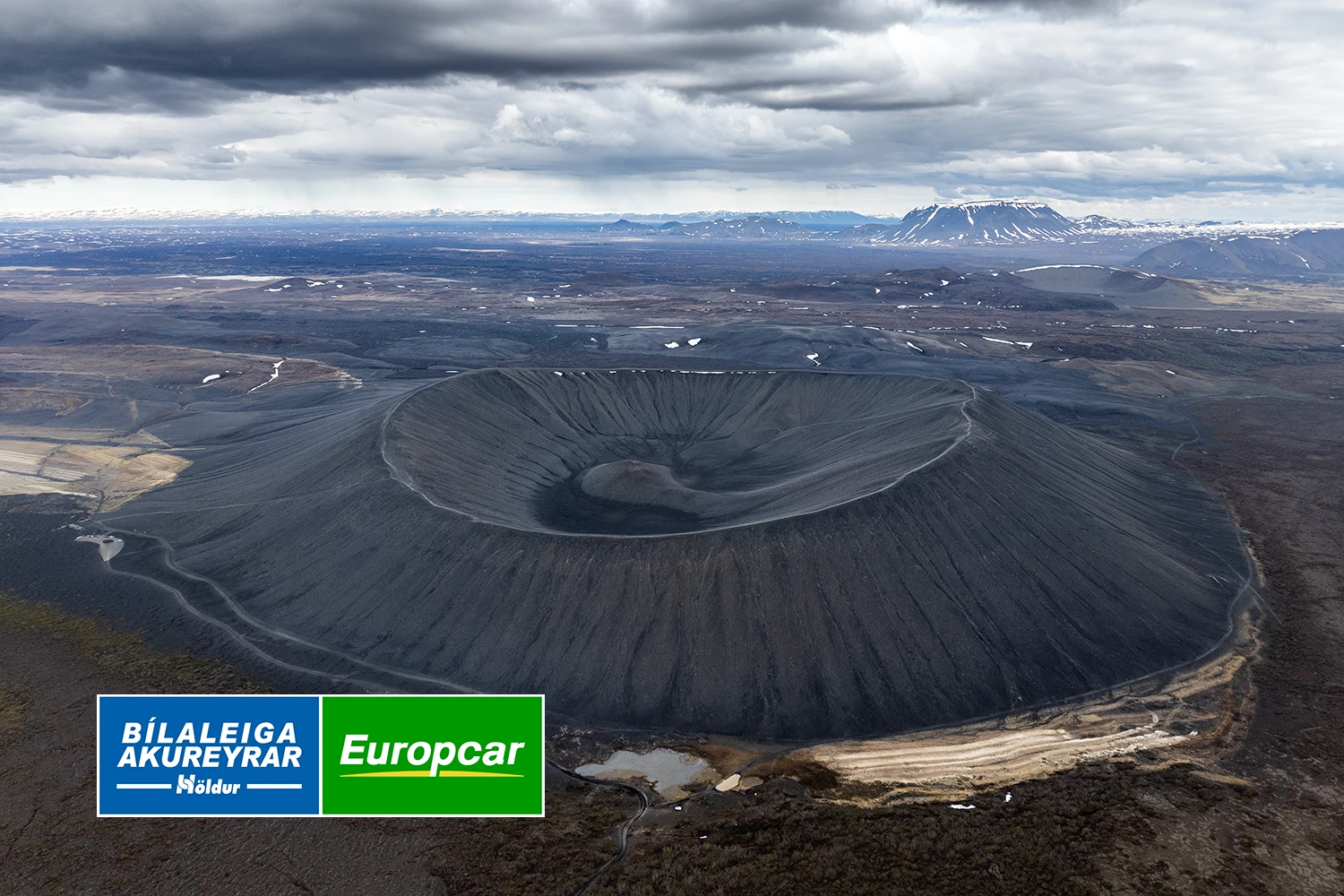
What to know about driving in North Iceland
If you’re visiting North Iceland, hiring your own vehicle is highly recommended. The sights are dispersed across nearly 1,000 km (620 mi) of coastline, and one of the great pleasures is to explore this region at your own pace.
Overall, North Iceland is a well connected region where roads are well maintained and frequently used. That said, though, there are some key things you should be aware of before hitting the road.
1. Be aware that roads in Iceland come in all shapes and sizes
Driving in Iceland might not be what you’re used to back home, as Iceland has a small population, very changeable weather conditions, and unique hazards that might catch you out.
One of the most important things to be aware of is the different types of roads you’ll encounter:
- Unpaved roads. Major roads such as Route 1, the “Ring Road”, are paved and easily navigable. But there are many roads in the region that are unpaved. Instead, these are gravel roads, which tend to be much less frequently used.
If you’re driving the Arctic Coast Way, for instance, you’ll find that about a third of the route is unpaved. As a result, you may want to choose a more robust vehicle such as a 4x4.
- Toll roads and tunnels. If you’re driving in North Iceland, you’ll likely encounter the country’s one and only toll road. It’s a tunnel known as Vaðlaheiðargöng and you’ll find it just to the east of Akureyri.
It’s important to be aware of this, as you'll need to pay for it either in advance or within 24 hours of passing through the tunnel. You can find out more in our guide to tolls and tunnels in Iceland.
- Road closures. In winter, some roads—particularly the most remote ones—can be closed quite suddenly. This is usually due to heavy snowfall.
It can be quite a stressful experience if you’re caught out by this. So, check your route in advance—and that means in summer too. You can access weather forecasts at the Icelandic Met Office and look for any road closures at road.is.
2. Decide what to do based on the season
Icelandic winters tend to offer snow-capped hills and long hours of darkness. In summer, expect the midnight sun and much milder weather—particularly in the north.
The season you visit will shape your itinerary and activities. For instance, summer in North Iceland is the most popular time for whale watching, as it’s when there are most creatures in the local waters.
Similarly, you’ll find that summer is the easiest time to explore Iceland’s highlands and more remote roads. It’s the perfect season to tour the Arctic Coast Way, for example, as some stretches of this road are regularly closed in winter.
But winter has its own charms. It’s the perfect time to see the northern lights in Iceland, with dark skies which accentuate the magical swirling colours.
In winter, the entirety of the Ring Road will be open and regularly cleared of any snow. You’ll also get to see the marvellous landscapes of Mývatn in its white winter coat.
3. Choose the right vehicle for your trip
The vehicle you drive will have a big impact on your comfort, as well as how easy it is to get around. For instance, smaller passenger cars may be more affordable, but they might not be the best choice for unpaved roads.
Choose your vehicle depending on what you’re planning to get up to in Iceland:
- 4x4 SUVs are a good choice if you’ll be exploring Iceland’s unpaved roads or the highlands. As they’re four-wheel drive, you’ll find they’re much better equipped for rugged winter road conditions too.
- Electric vehicles make sense if you’re planning a trip around the Ring Road. They’re affordable to run and typically come with the most advanced technology. However, we don’t allow our electric vehicles into the highlands.
- Motorhomes and campervans are the right choice if you’re intending to camp in North Iceland. They provide a comfortable, self-contained home for your trip.
Whichever you prefer, explore our full range of vehicles here.
4. Pack for all weather
At this point in this guide, you’ll know that the weather will have a big impact on your trip. But it doesn’t just determine what you get up to and which roads you choose. You’ll need to dress for the conditions too.
Here are our tips for packing for your trip to North Iceland:
- Always bring a waterproof. North Iceland might be the driest part of the country, but it can still rain. Don’t get caught out, because it can make an uncomfortable trip.
- Pack a spare pair of shoes. Driving in walking boots is hardly comfortable, but you don’t want to be walking around Iceland’s sights in light trainers either. Having a change of shoes is the best plan.
- Remember to pick up some insect repellant. The name Lake Mývatn in English translates to “lake of midges”. When the wind is low, these little flies can come out in swarms. They bite, so it’s best to be prepared with some bug spray.
- Prepare all the documents you need for your vehicle rental. With Höldur, you’ll need a valid credit card, your ID, and a driving licence that you’ve had for at least a year. The phone number of the emergency services can be useful too—it’s 112.
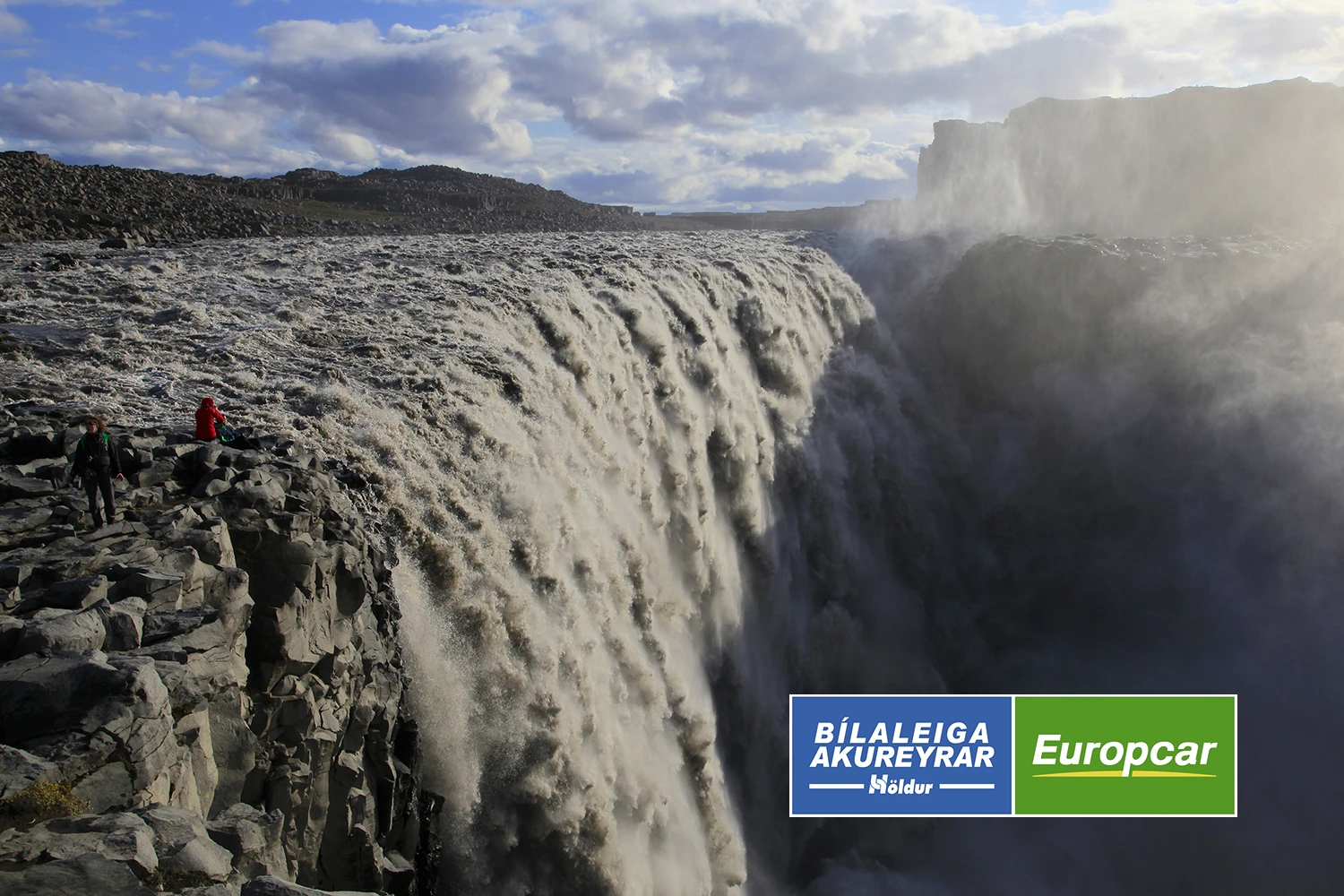
Frequently asked questions about visiting North Iceland
Need some more information? We provide the answers to some common questions here.
Is North Iceland worth visiting?
North Iceland is one of the most diverse and rewarding regions in the country. It’s definitely worth visiting.
One of the best ways to explore the region is in a rental car. It gives you the freedom and flexibility to travel at your own pace and see the sights that are most interesting to you.
When should I visit North Iceland?
You can visit North Iceland at any time of year. In summer, you’ll enjoy the midnight sun and dry, mild weather. Meanwhile, winter is the season of the northern lights, when snow covers the hilltops in white.
How long to spend in North Iceland?
Visitors typically spend between a couple of days and a week or more in North Iceland. It’s a region where you can slow down and take your time.
For instance, you can spend as much as 10 days to see everything on the Arctic Coast Way. Or you can choose some highlights of the region to visit on a shorter trip, or as part of a Ring Road adventure
Ultimately, it’s up to you how long to spend here. But no matter how long you have, expect an unforgettable adventure.
Can you see the northern lights in North Iceland?
North Iceland is one of the best places in the country to see the northern lights. As we’re so far north—on the edge of the Arctic Circle—the aurora borealis appears very strongly, particularly in the darkest months of the year.
There’s also the added benefit that North Iceland is much more sparsely populated than the south of the country. This means that there’s less light pollution to spoil the view.
What is the best time to visit North Iceland?
All seasons are a good time to visit Iceland—it just depends what you want to get up to.
Summer is a great time for whale watching, hiking, or camping out beneath the midnight sun. Alternatively, in winter, you’ll have the best chance to see the northern lights.
Spring and autumn can be ideal times to visit too. For instance, at these moments, there are fewer visitors around.
How to visit North Iceland?
There are three main ways for you to visit North Iceland:
- Hire a car and drive. Probably the most popular option is to hire a vehicle from Reykjavík and drive on the Ring Road to North Iceland.
- Fly from Reykjavík to Akureyri. Then, from the Capital of the North, you can hire a car to explore the region.
- Book a tour. Guided tours tend to offer fast-paced itineraries of the most famous sights. They’re good options if you’re in a hurry or you want to meet fellow travellers. But if you want to go at your own pace, they won’t be the best choice.
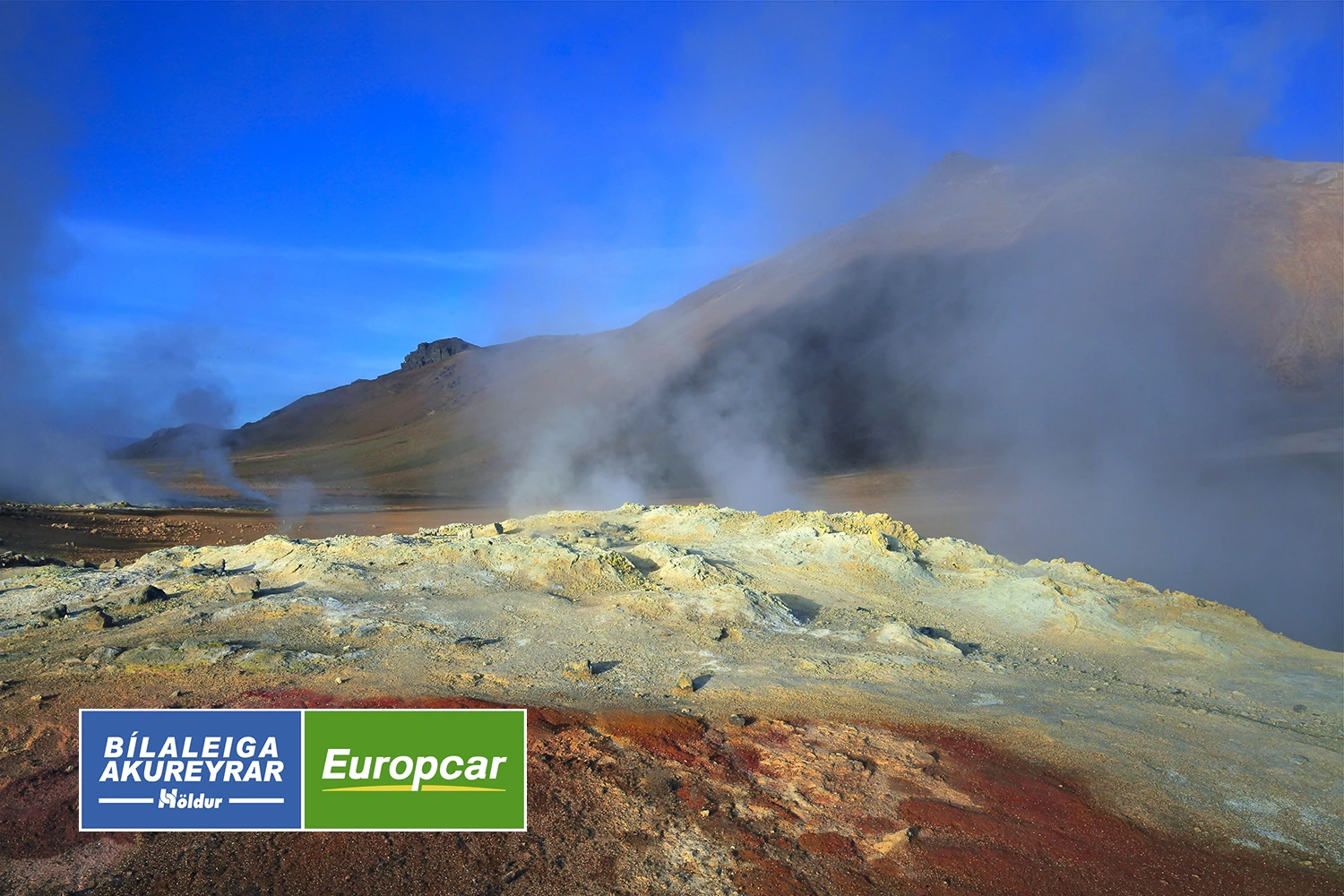
Visit North Iceland with Höldur
The best way to explore North Iceland is by car. Hire a vehicle and kickstart your Icelandic road trip today.
At Höldur, we’re the largest car rental operator in Iceland, as well as the local Europcar franchisee. We have over 8,000 vehicles in rotation, with rental outlets across the country, including in Reykjavík and Akureyri.
Explore our range of vehicles to find the best option for you.





